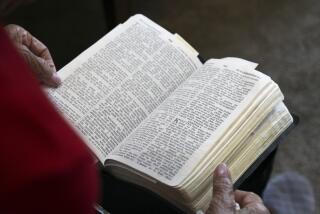Domesday Book 900 Years Old Next Year : England Sprucing Up Oldest Document
- Share via
LONDON — Experts are sprucing up England’s most famous book for its 900th birthday next year.
The Domesday Book, William the Conqueror’s survey of England, is the oldest public document in England. It is described as the most remarkable statistical record produced anywhere in that period.
“It is as much a cornerstone of our national heritage as the monarchy, or the Tower of London,” Dr. Geoffrey Martin, the keeper of public records, said at the Public Records Office, where the book is being renovated.
And an aide added, “Every English schoolboy knows at least three books--the Bible, Shakespeare, and the Domesday Book.”
When work on the book is finished, it will be exhibited to commemorate the anniversary and to celebrate the continuity of royal government from William I, who commissioned the survey, to Prince William, the eldest son of today’s heir to the throne, Prince Charles.
The two-volume Domesday (or Doomsday) Book is so named because it judged all men without bias, like the Last Judgment. As Jane Cox, an assistant records keeper, put it, “there was no appeal against the judgment of the evidence in the book.”
There had been nothing like King William’s survey in Europe since the days of Imperial Rome. It was an achievement of public administration that had no parallel until the 19th Century.
When William ordered the survey, it had been 20 years since the Norman Conquest, in 1066. Commissioners were sent out to inspect the land and to determine its ownership, along with the number of people and animals living on it.
The purpose of the survey has been in dispute. Some historians suggest that William was trying to improve tax collecting. Others say that he wanted to settle long-standing land disputes.
And it served a purpose probably not foreseen. According to Cox, the records keeper, “The history of many English villages started with their entry in the Domesday Book.”
The surveyors were strikingly efficient. In 20 months, they covered most of the English counties, and scribes using quill pens transferred the data to sheets of parchment at the Royal Treasury at Winchester, about 5 million words in all.
“The information was listed by owner rather than county or village,” one researcher said, “so there is a vast amount of facts spread at random . . . “
To try to make the book more comprehensible today, several universities are compiling data bases for computers based on the Domesday Book. One of these is the University of California at Santa Barbara.
The two volumes were bound first in Norman times and again in 1952; but specialists were not satisfied with that restoration, hence the current effort.
In the present operation, the parchment pages--more than 400 of them--will be removed and copied by means of high-quality photography. The copy will be published by Alecto Historical Editions and will go on sale next year at prices ranging from more than $2,000 for the principal volume down to about $150 for specially arranged county editions.
More to Read
Sign up for Essential California
The most important California stories and recommendations in your inbox every morning.
You may occasionally receive promotional content from the Los Angeles Times.








